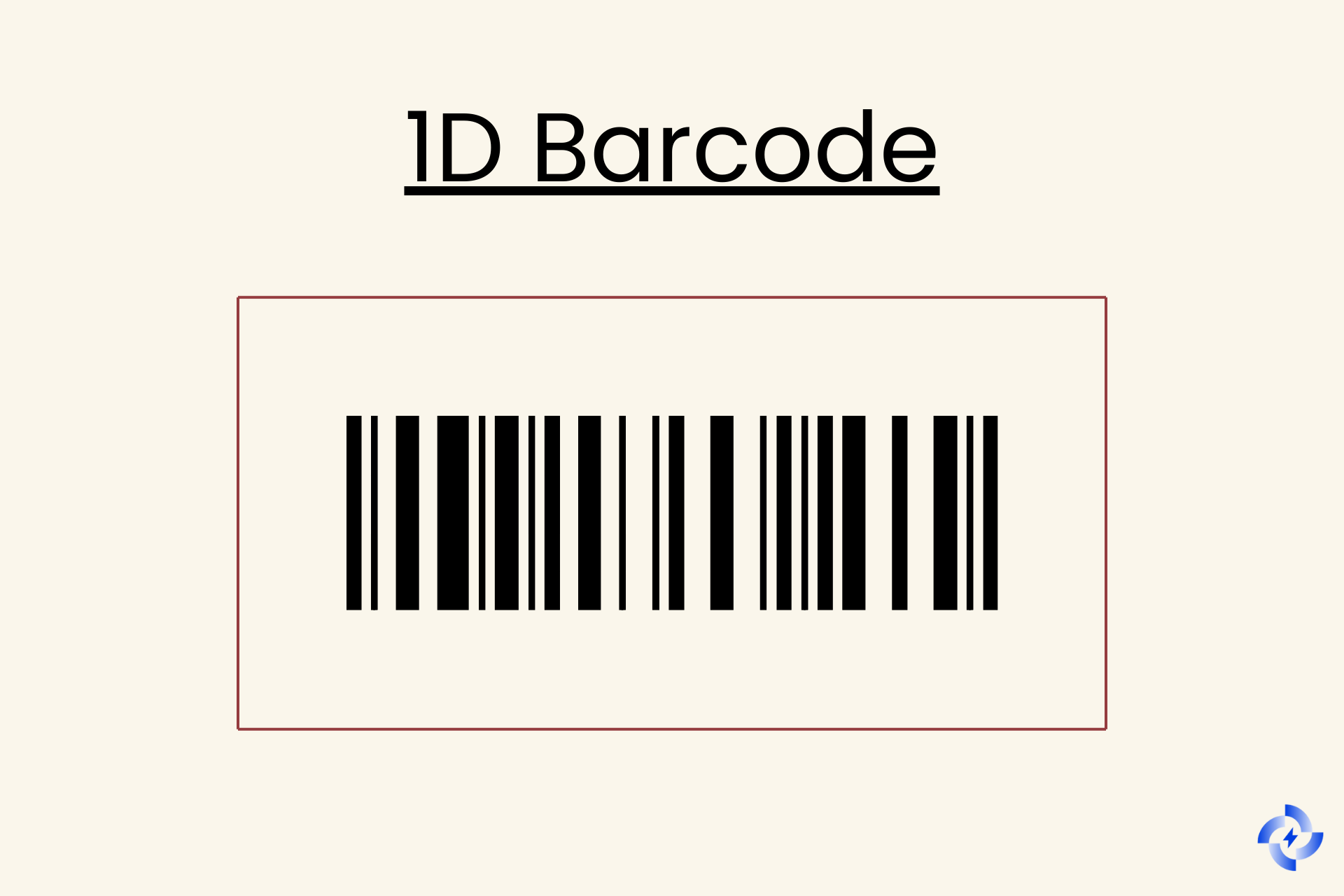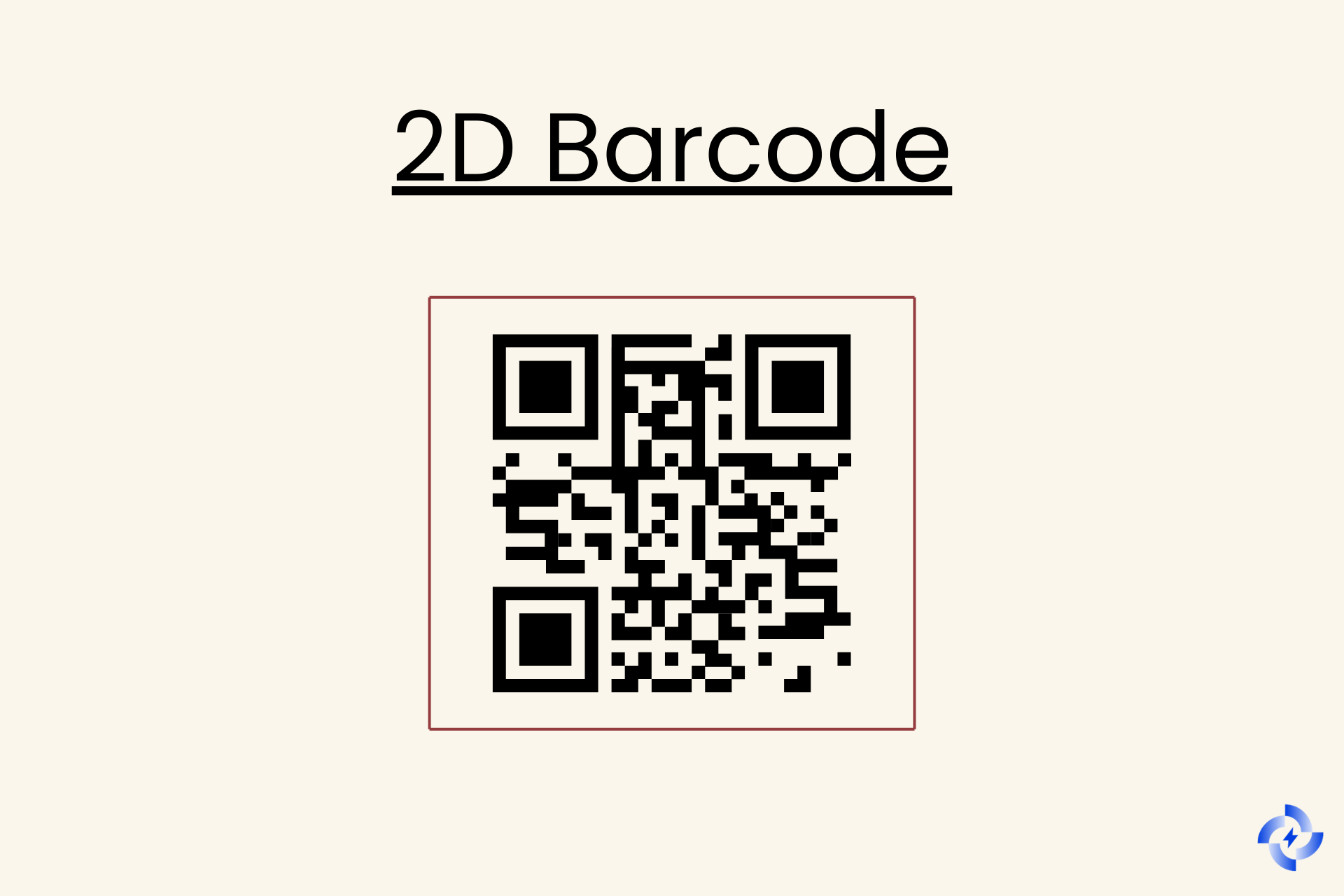The key difference between 1D and 2D barcodes is data storage and appearance.
1D barcodes, like the striped ones on product packaging, store basic information like a product ID. In contrast, 2D barcodes, such as QR codes, store more complex data using patterns of squares or dots.
In this post, you'll learn how each barcode works, their uses, and which one best fits your needs.
What Is a 1D Barcode?
A 1D barcode is the typical black-and-white striped code you see on products in stores. It looks like a series of vertical black lines of different widths, spaced apart by white gaps.

This type of barcode holds data in one direction (horizontally) and is used to store basic information like a product ID.
- Appearance: Horizontal black stripes on a white background.
- Data Capacity: Limited (usually a few numbers or letters).
- Common Uses: Retail products (e.g., groceries), inventory tracking.
Types of 1D Barcodes
- UPC (Universal Product Code): The barcode you see on most products at the grocery store. It helps identify items quickly at checkout.
- GS1-128: Used for shipping and logistics. Found on packages being transported between warehouses and stores.
- DataBar: Common in grocery stores for fresh produce, storing data like expiration dates.
If you want to see all barcode types, this content is for you: Barcode Types: Choose the Right One.
How Do 1D Barcodes Work?
Scanning: A laser reads the 1D barcode from left to right, picking up the different thicknesses of the lines and interpreting the spaces between them. The scanner translates this into product data by referencing a central database.
Example:
Think of when a cashier scans an item—like a can of soda—the laser reads the lines and pulls up the price and product information on the screen.
To get a broader perspective on how barcodes work: What is a Barcode & How Do Barcodes Work?.
Where to Use 1D Barcodes?
Retail: On product packaging for fast scanning at checkout.
Warehouses: To track inventory as items are stored or shipped.
Logistics: For scanning packages as they move from warehouse to delivery.
What Is a 2D Barcode?
A 2D barcode is more complex and can store data in both horizontal and vertical directions.

It doesn’t just look like lines; instead, it might be made up of small squares, dots, or patterns. The most common 2D barcode you’ve seen is likely a QR code.
- Appearance: A square grid of smaller dots or squares.
- Data Capacity: Larger, storing more complex data like URLs, text, or images.
- Common Uses: Scanning to access websites, track products in manufacturing, or get product details.
Types of 2D Barcodes
QR Code: Used for linking to websites, apps, and promotions. You might scan one with your phone to visit a website.
Data Matrix: Found on tiny items like electronics or medication, where space is limited but lots of information needs to be stored.
PDF417: Used on boarding passes or ID cards because it can hold personal data like your name or flight details.
How Do 2D Barcodes Work?
Scanning: Instead of just using a laser, a camera-based scanner captures the entire image of the 2D barcode, then decodes the pattern. This allows for much more data to be read quickly.
Example:
When you scan a QR code with your phone, it pulls up a webpage or app link. The scanner reads both the vertical and horizontal patterns to reveal the information.
For more insight about scanning, check out: The Ultimate QR Code Size Guide for Optimal Scanning
Where to Use 2D Barcodes?
Marketing: QR codes on posters, flyers, or product packaging that link customers to special offers or websites.
Pharmaceuticals: Tiny Data Matrix barcodes on medication packaging for tracking in the supply chain.
Electronics: On small parts or devices to store manufacturing details or batch numbers.
Key Differences Between 1D and 2D Barcodes
When comparing 1D barcodes and 2D barcodes, the differences boil down to data capacity, appearance, scanning method, and where they are used.
| Feature | 1D Barcodes | 2D Barcodes |
|---|---|---|
| Data Storage | Stores data horizontally (one direction). | Stores data both horizontally and vertically. |
| Appearance | Vertical black lines on a white background. | Grid or pattern of squares and dots. |
| Data Capacity | Limited, usually stores a few numbers or letters. | Higher capacity, stores complex data like URLs or text. |
| Scanning Method | Scanned by laser, reading left to right. | Scanned by a camera, capturing the entire image at once. |
| Common Uses | Retail, inventory tracking, logistics. | Marketing (QR codes), healthcare, manufacturing. |
1. Data Storage
- 1D Barcodes: These barcodes store data in a single, horizontal direction. They are perfect for storing small amounts of data, such as product numbers or serial codes.
- 2D Barcodes: Unlike 1D, 2D barcodes store data in both horizontal and vertical directions. This means they can hold much more information—beyond just numbers or codes.
2. Appearance
- 1D Barcodes: You’ll recognize 1D barcodes by their familiar look—black vertical lines of different widths on a white background.
- 2D Barcodes: 2D barcodes look more like grids or patterns of squares and dots. The most common 2D barcode is the QR code.
3. Data Capacity
- 1D Barcodes: Because they only store data in one direction, 1D barcodes can only hold a few numbers or letters. They are ideal for simple tasks, like identifying products at the checkout counter.
- 2D Barcodes: Thanks to their grid structure, 2D barcodes can store much more complex information, such as URLs, text, or even small images. This makes them useful in marketing, manufacturing, and beyond.
4. Scanning Method
- 1D Barcodes: These are scanned by a laser, which reads the barcode from left to right. This method is effective but somewhat limited in how much information it can process at once.
- 2D Barcodes: 2D barcodes are scanned using a camera-based scanner, which captures the entire image at once. This allows for faster and more detailed scanning, which is why 2D barcodes are becoming increasingly popular.
5. Common Uses
- 1D Barcodes: You’ll typically find these on retail products, in warehouses, and in logistics systems. They are ideal for tracking inventory or quickly scanning items at checkout.
- 2D Barcodes: 2D barcodes have a much wider range of applications. For example, you might scan a QR code on a poster to access a website, or find a 2D barcode on medication packaging to track it through the supply chain.
Are 2D Barcodes Better Than 1D Barcodes?
When comparing 1D and 2D barcodes, it’s easy to wonder, “Are 2D barcodes better than 1D barcodes?” The short answer: it depends on what you need.
1. Data Capacity
If you need to store more complex data, then 2D barcodes are the clear winner. 1D barcodes can hold only a few characters—usually enough for a product ID or simple number.
In contrast, 2D barcodes can store detailed information such as URLs, product descriptions, or even images.
So, if your business requires more than just basic data storage, 2D barcodes are more suited to your needs.
2. Scanning Technology
For scanning speed and flexibility, 2D barcodes also have the edge. 1D barcodes are scanned with lasers that read from left to right, limiting the amount of data that can be read at once.
2D barcodes, on the other hand, are scanned with cameras, capturing the entire image in a single go.
This makes 2D barcodes faster and capable of handling more complex scanning processes, such as QR codes that link directly to a website on your phone.
3. Use Cases
Where will you be using the barcode? 1D barcodes are perfect for environments where you need quick and easy scanning, such as retail stores or warehouses.
Their simplicity makes them efficient for tracking inventory or identifying products at checkout.
However, if you’re in marketing, healthcare, or manufacturing where you need to track more detailed data or link to external sources (like apps or websites), 2D barcodes are a better choice.
4. Cost Considerations
While 2D barcodes may seem superior in terms of data capacity and scanning, 1D barcodes are cost-effective and widely used, particularly in industries where their simplicity is an advantage.
Depending on the industry, you might not need the extra data that 2D barcodes provide, so sticking with 1D barcodes could save both time and money.
What Should You Consider When Choosing Between 1D and 2D Barcodes?
When deciding between 1D and 2D barcodes, keep these key factors in mind:
1. Data Complexity
- 1D Barcodes: Ideal for basic data like product IDs or prices.
- 2D Barcodes: Perfect for storing complex data, such as URLs, batch numbers, or product descriptions.
Tip: Choose 1D for simplicity, but if you need to store detailed information, 2D barcodes are the way to go.
Have you ever wondered how much data a QR code can store?
2. Scanning Requirements
- 1D Barcodes: Scanned using lasers, which are fast and cost-effective.
- 2D Barcodes: Require camera-based scanners, which capture more data and work with smartphones.
Tip: For fast retail scanning, stick with 1D. For more advanced uses (like linking to websites or accessing data on-the-go), 2D barcodes are better.
3. Space Constraints
- 1D Barcodes: Can be long and require more physical space on packaging or labels.
- 2D Barcodes: More compact, ideal for smaller items like electronics or pharmaceuticals.
Tip: If you’re tight on space, 2D barcodes are more efficient.
4. Cost Efficiency
- 1D Barcodes: Cheaper to print and scan, great for high-volume environments like retail.
- 2D Barcodes: Require more advanced (and sometimes more expensive) scanners, but offer more functionality.
Tip: 1D is more cost-effective, but 2D can be worth the investment if you need advanced data handling.
5. Future Scalability
- 1D Barcodes: A solid choice for current needs, but limited in terms of future growth and complexity.
- 2D Barcodes: More future-proof, especially if you plan to expand your digital or data needs.
Tip: If your business is growing and might need more complex data handling in the future, 2D barcodes are a better long-term choice.
Conclusion
In conclusion, choosing between 1D and 2D barcodes depends on your specific needs. If your business requires basic data storage, low-cost implementation, and simple scanning solutions, 1D barcodes are a great fit.
However, if you're dealing with complex data, need faster scanning, or want to link to digital content, 2D barcodes provide more flexibility and data capacity.
By considering factors like data complexity, scanning technology, space, cost efficiency, and future scalability, you can make an informed decision that best supports your business goals.
Whether you choose 1D or 2D, understanding what the differences are between 1D and 2D barcodes ensures that you’re using the right tool for the job.
Discover these blog posts before you go:
-> Different Types of QR Codes with Examples & Use Cases
-> What is a Barcode Inventory System & How It Works
-> How to Read a Barcode with 2 Simple Steps
-> QR Codes vs. Barcodes: Key Differences Explained
Frequently Asked Questions
1. Which barcode type is better for small product labels?
For small product labels where space is limited, 2D barcodes are a better option because they can store more information in a compact form. 1D barcodes tend to be longer, making them less ideal for smaller products or packaging.
2. Can I use both 1D and 2D barcodes in my business?
Yes! Many businesses use both types. 1D barcodes are often used in retail for quick product scanning, while 2D barcodes are used for things like QR codes in marketing or for tracking detailed information in manufacturing and healthcare.
3. Do 2D barcodes require special scanners?
Yes, 2D barcodes require camera-based scanners or smartphones to capture their data. However, these scanners are becoming more affordable and widely available. 1D barcodes, on the other hand, can be scanned using simpler and cheaper laser scanners.
4. Are 2D barcodes more secure than 1D barcodes?
Yes, 2D barcodes can offer more security features because they have the ability to encrypt data and store more detailed information. They are often used in areas like ID cards, boarding passes, and sensitive product tracking, where security is a top priority


